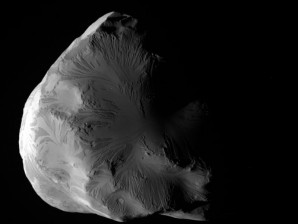Small asteroid swings harmlessly past Earth

An image released by NASA is a black and white image of Saturn's moon Helene made by NASA's Cassini spacecraft on June 18, 2011. At closest approach, on June 18, Cassini flew within 4,330 miles (6,968 kilometers) of Helene's surface. Cassini passed from Helene's night side to the moon's sunlit side. (AP Photo/NASA/JPL-Caltech/Space Science Institute)
LOS ANGELES— An asteroid the size of a tour bus streaked harmlessly past Earth on Monday, passing within 7,600 miles (12,230 kilometers).
Discovered only last week, the relatively small space rock made a hairpin turn around the planet at about 10 a.m. PDT (1800 GMT), sailing high over the southern Atlantic Ocean.
In truth, there was never any doubt it would miss. But given the vastness of the universe, 7,600 miles (12,230 kilometers) is practically a stone’s throw away, at about three times the distance between New York and Los Angeles.
The asteroid, dubbed 2011 MD, was initially mistaken by astronomers for a piece of space junk because it was so small, at up to 60 feet (18 meters) wide. Later observations confirmed it was an asteroid that had no chance of hitting Earth.
Asteroids of this size typically brush by Earth every six years. In fact, earlier this year, a smaller one came even closer to our planet, passing within 3,500 miles (5,630 kilometers).
Even if the latest one had aimed straight for us, it would have burned up in the atmosphere and not caused any damage on the ground.
“We’re just waking up to the fact that Mother Nature has been shooting these things across the bow for millennia,” said Don Yeomans, who heads the program that tracks potentially dangerous space rocks at NASA’s Jet Propulsion Laboratory in Pasadena.
It was expected to be bright enough that someone might be able to see it with a medium-sized telescope.
Asteroids are leftovers from the formation of the solar system some 4.5 billion years ago. Pieces of asteroids — meteorites — constantly break away and make fiery plunges through the atmosphere.
Objects bigger than two-thirds of a mile (one kilometer) are major killers and hit Earth every several hundred thousand years. Scientists believe it was a six-mile (10-kilometer)-wide asteroid that wiped out the dinosaurs 65 million years ago.
Scientists frequently monitor these potential threats to get better data on their paths and likelihood of hitting Earth. Over the years, NASA has identified and tracked 8,110 near-Earth objects — comets or asteroids — that are bigger than several feet (meters) across. Of those, 1,237 are considered “potentially hazardous asteroids.”
Though scientists, engineers and former astronauts have pondered ways to protect Earth from a catastrophic collision with an asteroid, there is no firm plan like something out of the Hollywood movie “Deep Impact.”
NASA is giving up the space shuttle program to send astronauts outside Earth’s orbit to an asteroid and eventually Mars. Unmanned spacecraft have flown by asteroids and even landed on them.
The large asteroid Apophis was high on scientists’ radar not too long ago after it was thought there was a 1-in-45,000 chance the 885-foot (270-meter) rock could hit Earth in 2036. Further observations downgraded the probability to 1-in-230,000.
Continually tracking asteroids large and small recently paid off. Three years ago, a small asteroid made a fiery but harmless dive into Earth’s atmosphere. Astronomers were able to give the world about six hours’ notice, the first time they were able to do so.
As for Monday’s close pass, it was just another chance for scientists to observe 2011 MD.
“This is fairly commonplace,” Yeomans said. “We’re becoming more aware of our neighborhood.”














